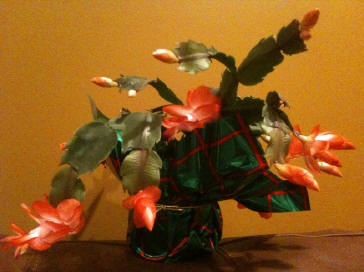Dawne Howard
Frederick County Master Gardener
 Since Grandma's day, the Christmas cactus has been a favorite houseplant. It's not unusual for a single plant to be passed down from generation to generation because they're long-lived, rather easy plants to grow. They are native to Central and South America. Hybridization over the past century has
resulted in many new varieties such as Thanksgiving, Christmas and Easter cactus. In September and October, Christmas cactus should be kept in a cool environment and have no artificial light at night. Indirect light is great for the day time hours. Allow the top of the soil to dry out before watering and do not place the
plant near fireplaces, drafty areas or heating ducts.
Since Grandma's day, the Christmas cactus has been a favorite houseplant. It's not unusual for a single plant to be passed down from generation to generation because they're long-lived, rather easy plants to grow. They are native to Central and South America. Hybridization over the past century has
resulted in many new varieties such as Thanksgiving, Christmas and Easter cactus. In September and October, Christmas cactus should be kept in a cool environment and have no artificial light at night. Indirect light is great for the day time hours. Allow the top of the soil to dry out before watering and do not place the
plant near fireplaces, drafty areas or heating ducts.
The next Christmas plant is the traditional red poinsettia. Poinsettias thrive on indirect natural light and cool temperatures (65-70 degrees). They also require moderately moist soil, so water only when the soil feels dry to the touch. Poinsettias are not poisonous. While they are not meant to be
eaten by humans, pets or livestock, ingesting poinsettias would probably cause some stomach upset, as would eating any houseplants. They have gone through extensive testing and there is no evidence that they are toxic or unsafe to have in the house. They are also safe to put in the compost.
Amaryllis bulbs are very popular at this time of the year too. As a bulb, it shares some care and growth methods used with other bulbs. This bulb does not require pre-cooling to be forced. Begin the forcing process 6-8 weeks before the bloom is desired. Water the potted bulb ONCE thoroughly from the
top and the bottom of the pot. Over watering at the beginning of the amaryllis growth is the main reason for failure. It is best to water by placing the pot in a pan of water of a level halfway up the pot height, to allow the soil to draw up water through the base of the pot. You may have to provide support for the flower
stem when the blooms open. The amaryllis does not have to be placed in bright light or sunlight. Heat and light causes the blooms to wither. Be careful to not let the pollen of the flower get on fabrics-it can stain some cloth.
The fourth flower of the season is the cyclamen. This flower comes from a tuber. They love cool temperatures. As a matter of fact they go dormant in hot weather. Water these plants when the soil surface feels dry to the touch. This plant prefers to receive a good soaking then dry out partially
before being soaked again. As the flowers begin to fade, gradually allow the plant to dry out for 2-3 months. It's going into a dormant stage. In the spring you can place it out doors in a cool spot and lay it on its side so the tubers do not root from to much water. They should begin to develop new growth in the fall when
the cool weather begins.
The last flower I will mention is the paper white narcissus. It is the most fragrant of the flowers I have mentioned. It is a relative to the daffodil. This bulb does not need pre-cooling either. Place the bulb in a soil less mixture in a cool bright room. Once the new growth shoots are one to two
inches tall, move the bulbs to a warmer location. Forced paper white produce blossoms 4-8 weeks after being potted Paper whites grow so tall that they can flop over. So with the following formula you can stunt the growth but not affect the blossoms. Water them with a diluted solution of 5% alcohol. The formula is one part
rubbing alcohol with 10 parts water. Once the paper whites are two inches tall, switch the water to an alcohol mix. If you are growing the paper whites in water and stones, be sure to add a handful of charcoal to the bottom of the container before planting to keep the water fresh. . When the plant flowers it can be moved
out of direct sunlight into a cool place. Paper white bulbs cannot be saved for another season of bloom, so you can dispose of them once they are no longer blooming or attractive.
Read other articles on house plants
Read other winter related gardening articles
Read other articles by Dawne Howard